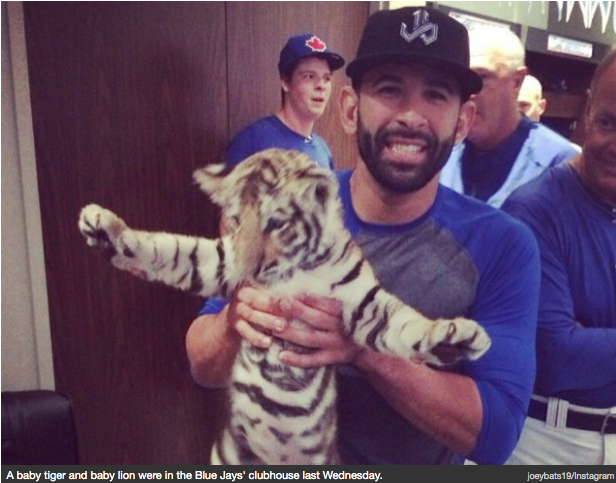 This story showed up in my FB feed this morning and I thought some of you might be interested, especially in how the various constituencies have framed their positions. Here’s another article in which the team’s General Manager speaks up.
This story showed up in my FB feed this morning and I thought some of you might be interested, especially in how the various constituencies have framed their positions. Here’s another article in which the team’s General Manager speaks up.
Month: September 2014 (Page 2 of 4)
My image was inspired by Abigail’s post about competitive horseracing and focuses on the use of animals for entertainment. Like Abigail, I wanted to pick an image that represents a human-animal relationship in which the human is in control so I chose a picture of a Sea World trainer performing tricks with her orca. At first glance my image seems very innocent because it shows a happy trainer standing on the nose of an orca entertaining a crowd, but when you analyze this image it becomes clear that the trainers that interact with their orcas have more of a master-slave relationship rather than a performer-assistant rapport.
The first thing that I noticed in my image is that the trainer is on top of the whale, which insinuates that she has dominance over the animal. This subtle feature of the image signifies that the trainer has control over the whale’s actions and that the orca is submitting to her. When I first saw a Sea World show I didn’t think much of this relationship because I figured doing tricks for a crowd was more rewarding than swimming aimlessly in the wild, but after reading the Walker text I’ve become disenchanted with this practice. In the Walker text the author compares horse breeding to the practice of slavery by pointing out that in each case the victim is being held captive to serve a single purpose and then is discarded when that purpose has been fulfilled (Regan 185). In the picture I chose the orca is also used for a single practice, which is entertainment, and then is sent away once it becomes too old to serve that purpose. The CNN Documentary film Blackfish provides more insight about this practice by explaining that the orcas that are used in SeaWorld shows are usually bred in captivity for the sole purpose of growing up to be a part of the SeaWorld shows (Blackfish). In “Am I Blue” Walker would make a similar argument by insisting that Blue is being used for the sole purpose of creating a desirable offspring that the breeders can then sell for a high price. In both scenarios the animal in question is being exploited for the economic benefit of others and is no longer seen as valuable once its duties have been performed.
Using whales for entertainment may not seem like a horrible thing but when you learn the facts, like that they spend their whole lives in a small aquatic cage and perform several hours a day, you realize that they are essentially slaves that are used for our amusement. The whales that are being used in these shows are no different from many horses that are used for breeding in the sense that they are taken from the wild against their will and are forced to perform a task for the benefit of others.
Another reading that I had of this image was that it seemed to really embody the dualism that Berger talks about in the reading. Here is an organization whose mission statement is to, “Advance the global understanding of killer whales, and educate and inspire conversation efforts to protect those in the wild,” yet the way that they’re “inspiring conservation efforts” is putting animals into bodies of water that are way smaller than the ones found in their natural habitat (Blue World Project). I think there is an incredible amount of irony in this practice because if you were truly dedicated to educating and conserving you would teach people about whales in their natural habitat and not take them from their home and place them in an artificial sea. I understand that SeaWorld is a business that uses their shows to educate as well as entertain, but I think that those who train and use whales in shows are failing to see the psychological ramifications that their actions are having on the wellbeing of these whales.
Work Cited
1. Berger, John. About Looking. New York: Pantheon, 1980. Print.
2.Blackfish. Dir. Gabriela Cowperthwaite. Magnolia Pictures, 2013. DVD.
3. “Blue World Project.” Blue World Project. Sea World Parks and Entertainment Inc., 5 Apr. 2014. Web. 14 Sept. 2014.
4. Regan, Tom, and Andrew Linzey. Other Nations: Animals in Modern Literature. Waco, TX: Baylor UP, 2010. Print.
Blog Post #2 Looking into an enslaved monkey’s eyes
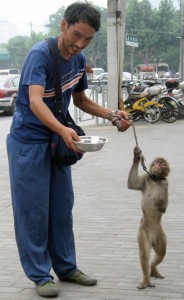 I chose an image from Wikipedia that is a good representation to the modern human-animal relationship. In the picture, a man and a monkey are on the street. The man with a bowl in his hand is begging for money. The really shocking thing about this image is that the man is also holding a rope that surrounds a monkey’s neck. Obviously, the man is leading the monkey. There is smile on the man’s face. The monkey appears to be suffering because he is clenching his fist around the rope. This picture represents a modernized slavery. The only difference is that this is human enslaving animal not human enslaving human.
I chose an image from Wikipedia that is a good representation to the modern human-animal relationship. In the picture, a man and a monkey are on the street. The man with a bowl in his hand is begging for money. The really shocking thing about this image is that the man is also holding a rope that surrounds a monkey’s neck. Obviously, the man is leading the monkey. There is smile on the man’s face. The monkey appears to be suffering because he is clenching his fist around the rope. This picture represents a modernized slavery. The only difference is that this is human enslaving animal not human enslaving human.
In Berger’s essay “Why look at animals?” John Berger discusses the enslavement of animals, he quoted Buffo in his work, “ To the same degree as man has raised himself above the state of nature, animals have fallen below it: conquered and turned into slaves”. In this image, the man is at a higher level than the animal. Perhaps the man is being mistreated in real life; he is living at the bottom of human society. However, he could easily vent his anger on the monkey. Mistreating the monkey makes the man feel satisfied that there is always something that underneath him. As Berger says, “They are creatures of their owner’s way of life, the pet completes him”. The monkey is a testimony to the dark side of humanity: how human is willing to scarify another species to fulfill their own satisfaction.
Also the reasons why the man in the picture wants to bring a monkey when begging are worth exploiting. Sadly, the street where the man is begging with the monkey is just a few miles away from my home and I have seen beggars with monkeys more the once in China. Normally, the man trained the monkey to do some tricks or maybe just made the money to make the same begging gesture. Some pedestrians might find the monkey “cute” or “funny” and give the man some money. To the man, the monkey’s value is purely instrumental. The monkey is just served as a tool to make money for the man. The intrinsic value of the monkey is being neglected completely. In Alice Walker’s essay “Am I blue?” she talked about how human has forgotten animal’s right completely, “there are those who never once have even considered animals’ rights: those who has been taught that animals actually want to be used and abused by us”. The reason why this kind of begging is alive not only comes from the man who abuses the animal, but also comes from the indifference to the mistreatment to the animal from the whole society. The whole society is marginalizing animal.
Sources for the post:
“Shanghai-monkey” by F3rn4nd0 – File: Shanghai man with monkey.jpg. Via Wikipedia – http://en.wikipedia.org/wiki/File:Shanghai-monkey.jpg#mediaviewer/File:Shanghai-monkey.jpg
John Berger. “About Looking”. Pantheon Books, 1980 print. Sept 10 2014
Walker, Alice. “Am I Blue.” Human Rights Anthology. Ed. Lee Peralta. New York: Columbia U. Press, 1995. 438-445. Sept 16 2014
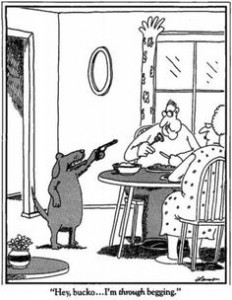
Although my time in class has not dramatically affected my attitudes and views regarding human-animal relationships, it has encouraged me to put much more time and effort into thinking about and analyzing the source of these views and their underlying components. When I came across a Far Side comic drawn by cartoonist Gary Larson, I found myself searching for details that would tell me more about what Larson was attempting to say about human-animal relationships.
The comic depicts a domestic scene with a couple eating dinner in their living room and the family dog on the floor nearby. The dog is highly anthropomorphized, standing upright on two legs and wearing an angry expression that would be more at home on a human face than a canine one. The dog is wielding a revolver pistol and aiming it directly at his owner, and the caption reads, “’Hey, bucko…I’m through begging.’” Although they are being held up by their dog over food, neither human in the image appears at all concerned. The man looks at the dog with a blank expression and his mouth full of food, while his wife seated opposite him doesn’t even give the dog any heed.
Before joining this class, I would have found the image moderately amusing and moved on to other ventures. However, now that I have spent time in class thinking in much more depth about human-animal relationships, this seems to be an exaggerated example of the impact that exploitation at the hands of humans can have on animal psyche. The dog is clearly fed up with his low-ranking position in the household and his use as a novelty as a pet. Blue, the horse in Alice Walker’s Am I Blue?, experiences the same feelings as he is left alone in his field until he is wanted for human purposes, be them riding or breeding. Even when under these circumstances, Blue is treated as an object and not as a living being since the children who ride him, “ride furiously for ten or fifteen minutes, then get off, slap Blue on the flanks, and not be seen again for a month or more.” His mate is also taken away immediately after he impregnates her, hammering home the point that Blue is simply seen as a tool by his owners. Like Gary Larson’s dog, Blue also becomes fed up with this and snaps after his mate is removed, wearing, “the look of disgust with human beings, with life; the look of hatred.” Both the Far Side comic and Am I Blue? Are making the point that when their intrinsic value is ignored in favor of their instrumental value, irreversibile damage is done to the human-animal relationship.
Sources for the Post:
http://media-cache-ak0.pinimg.com/236x/f3/e6/f8/f3e6f810211343108914aa115b1c37b4.jpg
Regan, Tom, and Alice Walker. “Am I Blue?” Other Nations: Animals in Modern Literature. Waco, Tex.: Baylor UP, 2010. 182-187. Print.
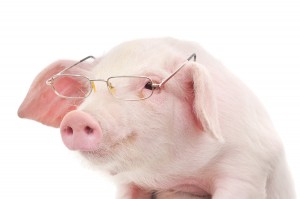
Since reading Berger’s and Walker’s passages in class, I cannot say that I have a radically new and enlightened view on how animals are depicted. However, I can say that those passages help me view these depictions in a slightly new way by shedding new light. Viewing the way farm animals are treated has always been an issue important to me. Nowadays, producers and distributors of meat products have tried there best to unanthropomorphism the connections between animals and humans. They focus on engraving only the instrumental value of animals in the minds of the consumer, as opposed to the intrinsic values.
Seeing images like the one posted above, is not the most common image of a pig that most see. This picture depicts what looks like a very intelligent pig. The pig is in a position similar to what the “quintessential librarian” looks like- glasses and posture together. The pig looks soft and clean. It even looks like the pig has a grin.
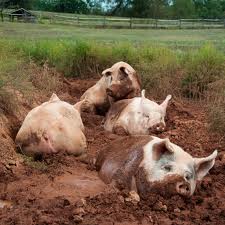 Most would say that this image is what pops in ones head when one thinks of pigs. Now it isn’t a bad thing to associate pigs playing in mud, since it is natural for them. However, by reinforcing this image in ones head, one subconsciously propagates the stereotypes and prejudices society has instilled with pigs- which is that they are dumb, dirty, fat, and nasty.
Most would say that this image is what pops in ones head when one thinks of pigs. Now it isn’t a bad thing to associate pigs playing in mud, since it is natural for them. However, by reinforcing this image in ones head, one subconsciously propagates the stereotypes and prejudices society has instilled with pigs- which is that they are dumb, dirty, fat, and nasty.
Reading Berger has shown me the deviations, as a society, we have taken in our previously dualistic mindset. We used to treat animals with respect and value, respecting their intrinsic value and instrumental value at the same time (1). Today, we don’t even go that far in respecting them. Alice Walker makes a point in Am I Blue? where she opens conversation about the way we treat animals is similar to the way we treat minorities- for instance, the way white people treated black people during slavery in the United States. If one witnesses how a factory farm operates, one would be appalled in the treatments of the animals. You could equate the way the pigs and other animals are being treated to conditions slaves endured.
Most are not aware of the intelligence that pigs have. Hence why, the producers of the first image created the picture. They made the pig appear intelligent. They are tying to start a conversation to break down the common misconceptions society holds on the intellect of farm animals. Some scientists believe even that pigs are smarter than dogs, smarter than dolphins, smarter than 3-year-olds (2). So if in society we really choose the food we eat by its intelligence- we will not eat monkeys, dogs, cats, etc. due to their intellect but we will eat a cow, pig, and chicken because of their inferior intelligence-, I believe we will see many contradictions arising from scientific data on the actual intelligence of farm animals.
Now, I am not advocating that we all become vegetarians and completely cut out meat from our diets; however, I believe this quote sums up my thoughts quite well:
“If we’ve decided to eat pigs despite the fact that they are smart, should we not at least use the information that we have to make their lives as positive as possible up until the point when we decide, “Well now they’ve become food?”
Sources:
(1) Berger, John. “Why Look At Animals?” About Looking. New York: Pantheon, 1980. 7. Print.
(2) “Pigheaded: How Smart Are Swine?” Modern Farmer. N.p., n.d. Web. 13 Sept. 2014.
(3) Walker, Alice. “Am I Blue?” Other Nations: Animals in Modern Literature. Ed. Tom Regan and Andrew Linzey. Waco, TX: Baylor UP, 2010. N. pag. Print.
The image that I have chosen shows a baby pig in the hands of a human. It looks like the pig and human are in a grassy area and the pig appears to be looking at the viewer of the picture. This picture depicts the animal as very cute and loveable, but also somewhat helpless based on its size and the careful way that it is being held with two hands. Because the human is holding the pig, the relationship between the pig and the human seems to be shown as a caretaker/pet relationship. When I first saw this picture, I thought that it may have been a pet pig based on the way that it is being held and because small pigs are now becoming a common house pet. However, when I looked on the website that this picture came from, I learned that this picture is actually used on a website that provides information about a “Master of Animal Science” program. The text around the image explains the program and how it provides information about caring for animals, as well as “practical applications in areas from captive animal care to recreation, sport and biological research.” There is no caption that provides information about this individual pig, and it is possible that this image was only chosen to capture the attention of animal lovers who may be interested in a career working with animals. This picture seems to show a caring relationship between the human and animal, and contrasts the actual purpose of the major which is primarily focused on the use of animals as a resource.
Before reading Berger, I would have viewed this image and simply appreciated how cute it was. I would not have given a lot of thought about the context of the picture or what the actual life of this specific pig is like. Now that I have read Berger, I am much more interested in the life of this individual pig and how it is treated. Although this picture may originally give the viewer a sense of the intrinsic value of the pig because it appears to be looking at the viewer and is very cute, the website that this picture is used for is actually primarily concerned with the instrumental value of the pig. Berger would likely comment that this picture proves that human ambition has led to the marginalization of animals. Despite the fact that this image seems to portray an individual life, the purpose of the website is less focused on individual animals and is more focused on what humans can gain from groups of animals as a whole.
References:
Berger, John. “Why Look at Animals?” About Looking. New York: Vintage, 1977. 3-28. Print.
http://www.land-environment.unimelb.edu.au/future-students/grad/animal-science.html
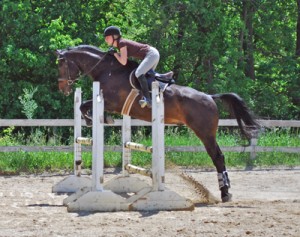 After reading Berger and Walker, I have begun to think of holding a horse in captivity for recreational purposes in a different light. The image that I have selected, shown above, depicts a competitive rider forcing a horse to jump over an obstacle. This image comes from the Chestnut Hill Farm website which is a farm that offers equestrian lessons. It appears that the horse is her property and that the rider is the slave-owner whereas the horse is her slave. This image glorifies the sport of competitive riding. The assumption is that the purpose of the horse is for the control of the rider. The better control the rider has of the horse, the more successful the rider is considered. After reading Walker’s essay, I noticed the firm grip that this woman has on the reins of the horse. That is not something that I would have noticed before and I wonder if it is an indicator of the power struggle between her and the horse.
After reading Berger and Walker, I have begun to think of holding a horse in captivity for recreational purposes in a different light. The image that I have selected, shown above, depicts a competitive rider forcing a horse to jump over an obstacle. This image comes from the Chestnut Hill Farm website which is a farm that offers equestrian lessons. It appears that the horse is her property and that the rider is the slave-owner whereas the horse is her slave. This image glorifies the sport of competitive riding. The assumption is that the purpose of the horse is for the control of the rider. The better control the rider has of the horse, the more successful the rider is considered. After reading Walker’s essay, I noticed the firm grip that this woman has on the reins of the horse. That is not something that I would have noticed before and I wonder if it is an indicator of the power struggle between her and the horse.
I found Walker’s analogy between animal captivity and historical slavery interesting and wondered how it could apply to this image. After reading Walker’s work, when I look at this picture I think about what the horse may be feeling or what may be going through the horse’s mind. Previously, I would not have focused on the horse or even thought how the horse may be emotionally affected by being held captive for the purpose of being ridden. After reading Berger and Walker, I find myself viewing this image from the animal’s point of view which has raised several questions for me.
The horse has been reduced and marginalized in order to fulfill the rider’s recreational needs. This is comparable to Berger’s ideas about how we reduce and marginalize animals by keeping them in zoos for our own entertainment. This interpretation of the image is different from how I previously viewed equestrianism. I used to think that it was exciting and fun. I even considered it something that I was interested in doing because I love horses. However, after reading Berger I realized that truly loving an animal does not involve marginalizing that animal. Berger’s view that capitalism is a large cause behind the reason we view animals for their instrumental value struck me and made me wonder if that idea could be applicable to the mission of Chestnut Hill Farms. Chestnut Hill is capitalizing on the horse’s majestic nature by making the sport look beautiful and graceful in this image. The image is focusing on the instrumental value of the horse while completely ignoring its intrinsic value.
Often, we treat animals the way we treat human beings in many aspects. My interpretation of this image human-animal relationships after reading Berger and Walker caused me to think about human-human relationships in a similar context. For example, human slaves were sold as gladiators during Ancient Roman times for the entertainment of the people. Similarly, animals such as horses are being sold for recreational purposes as well. Berger and Walker have gotten me thinking about whether keeping animals (both human and non-human) captive for recreational purposes is ethical. It also raised the difficult question of whether it is possible to have an animal as a pet and still give it full life. This is a question I have begun thinking about after reading Berger and Walker but have still not come up with an answer to because I do not believe that there is one simple answer to this question. I believe that the ability to give a pet full life has to do with how the animal is treated as well as if the owner views the animal for its intrinsic or instrumental value.
References:
Chestnut Hill Farm, 2014. Web. 10 Sept. 2014.
John Berger. “About Looking”. Pantheon Books, 1980. Print.
Walker, Alice. “Am I Blue.” Human Rights Anthology. Ed. Lee Peralta. New York: Columbia U. Press, 1995. 438-445. Print.
I found this picture in an advertisement website, where the advertisement is promoting “A day of being a zookeeper”. Therefore, this picture is a perfect way to represent what a great day you can have by being a zookeeper! At first glance, this picture looks as if both the zookeeper (the woman in the photo) and the serval (type of cat) are content with their situation during the moment of the picture. The zookeeper is wearing a smile on her face that runs from ear to ear, the serval and the zookeeper are both seemingly sharing a hug, and it even looks as if the serval is enjoying the hug; her ears are perked up as if it were a dog when it hears the word “walk”, and it even looks like she has a smile running through her face. This image makes the viewer assume that every person in this image (including the serval) is enjoying the moment at the zoo. But as you look deeper into the picture, you can see that there is a more critical perspective of this image.
The first part of the image that can be dissected is the background zoo. Tall grasslands, woods, savannahs, and other places associated to these types of habitats are mostly where servals are habituated. Concrete and boulders, as shown in the background, are not. Berger would say that the only reason we believe that this is a happy picture of a serval and a zookeeper is because of our nostalgia of zoo’s and how we see these types of animals as magical because of this great nostalgia of something we are not used to seeing. By remembering the way these zoo animals were in our nostalgia, we are creating in our minds the image of a serval, and by creating this image we are devaluing the actual animal for how it is because this animal will never live up the expectations our minds create.
Alice Walker would look at the way the animal actually feels, rather than where it is located. At closer look, the eyes of the serval tell its real emotions. The serval looks fiercely focused into space, which in many animal languages, is a sign of basically saying “back off”. Secondly, the “smile” can be interpreted as the serval’s hiss, also a sign of “back off”. The serval seems to be actually trying to push its self away from the zookeeper, instead of into the zookeeper.
By searching zookeeper into the internet, I knew I would be able to find an image that seems so inviting and loving towards animals, but could also be shown to have a more critical side to how we as humans are related to animals.
Works Cited:
Berger, John. Why Look At Animals?. New York: Vintage International, 1977. Print.
Walker, Alice. “Am I Blue?”. Other Nations. Baylor University Press. 182-187. Print.
http://www.zavvi.com/gift-experience-days/zookeeper-experience-zookeeper-for-a-day/10051858.html
http://www.servals.org/wild.htm
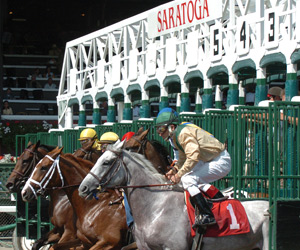 The image that I want to look at and discuss focuses on horses. For the majority of my life, I lived in Upstate NY near Saratoga. For those of you who don’t know, Saratoga is famous for its’ race track. This image centers around the relationship between horses and humans. As clearly shown in the picture, the jockey (human) is dependent on the horse. It is also widely believed and understood that there is a close knit relationship between horse and human. The assumptions regarding the relationship is that the human is primarily in control of the horse and will respond to the human’s commands. Along with that, the horse tends to “match” its’ jockey (similarly colored reigns) and both the human and horse are assigned a number. The image to me shows more of a competition between jockey to jockey and not a competition from horse to horse. I feel like there is more of a focus on the first jockey in the image than there is on the horse. The jockeys are the ones who seem focused on their goal with the tensed body language, whereas the horse seems more as if it is just there because it has to be based on its demeanor.
The image that I want to look at and discuss focuses on horses. For the majority of my life, I lived in Upstate NY near Saratoga. For those of you who don’t know, Saratoga is famous for its’ race track. This image centers around the relationship between horses and humans. As clearly shown in the picture, the jockey (human) is dependent on the horse. It is also widely believed and understood that there is a close knit relationship between horse and human. The assumptions regarding the relationship is that the human is primarily in control of the horse and will respond to the human’s commands. Along with that, the horse tends to “match” its’ jockey (similarly colored reigns) and both the human and horse are assigned a number. The image to me shows more of a competition between jockey to jockey and not a competition from horse to horse. I feel like there is more of a focus on the first jockey in the image than there is on the horse. The jockeys are the ones who seem focused on their goal with the tensed body language, whereas the horse seems more as if it is just there because it has to be based on its demeanor.
Before reading either Berger or Walker, I would not have really put in a lot of thought in regards to what this image represents to me. Especially since I grew up around this race track, it came off to me as incredibly normal and a part of daily life. I always automatically assumed that horses and their jockeys held some special bond and that they perceive each other as equals. However, after reading “Am I Blue?” by Walker, my perception changed. After reading Walker, I saw the horses in this image as being neglected. My perception changed from a passive view of the animal to an active one – and my active perception recognized that the horses are being treated solely as if they only possess instrumental value. Walker would disagree immensely with the entire concept of horse racing – as it does not take into account the horse’s needs and emotions. Along with that, Berger would also state that this is mistreating the animal. The horse in this image is not a horse – it is simply a number and a name used for entertainment and monetary purposes. With the entertainment culture surrounding this image, the horse loses all sense of individuality and “horseness” (Walker). The animal is entirely marginalized – no longer is a horse a horse, now it is a form of entertainment. The horse is nothing more to the general audience as a car would be in the Nascar world. The relationship between horse and jockey is also something that I may have overestimated in my mind, which I recognized after reading Walker. The jockey and the horse probably do share a relationship and a bond, but I still did not take into account that the jockey’s success and pride comes out of what the horse can give him; therefore the horse becomes an instrumental object in the jockey’s life. All in all, I realized that my perception shifted from a passive view to one that takes into account the intrinsic value of the horse, as well as recognizing how the horse is simply just an accessory to the human as shown in the image. After reading Berger and Walker, I now view horse racing as marginalizing the animal and shifting its’ value from intrinsic to instrumental.
I’m not sure why I picked this picture I just like hedgehogs….
My name is Emma. I am a junior and a bio major. I have an older sister who also went to Lafayette and she graduated in 2010. I live in a really small town in New Jersey at the beach. In the summer, I spend all my free time at there and playing tennis. I went to Biotechnology High School and it was very science focused. I didn’t particularly enjoy going there. My parents met at a ski mountain in upstate New York so since before I was born our family has been skiing at Hunter Mountain. I’m involved in a few clubs on campus including the Lafayette Activities Forum, as Director of Marketing and Outreach.
I was a mechanical engineer for two years, however I have since reevaluated my life plan and realized that I am not meant to pursue that career. When I was little I once told my family I wanted to be a flower, then after realizing this dream wasn’t possible, I decided I wanted to be a zoologist, and then a vet. I wanted to be an artist in high school because I was so fed up with science. I wanted a job out of school though so I went to engineering because my physics teacher told me I’d be good at that. I still don’t have a completely clear path that I’m on right now. I think I may want to become a pediatrician someday.
My favorite animal is an elephant so here is a video of a cute little elephant: here
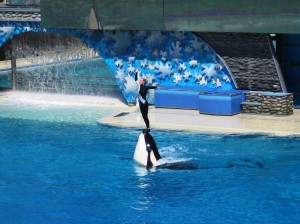

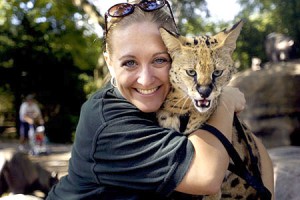
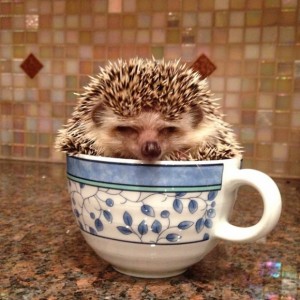
Recent Comments